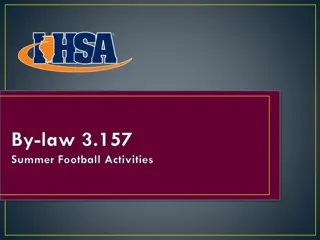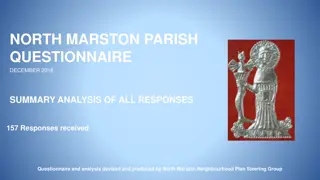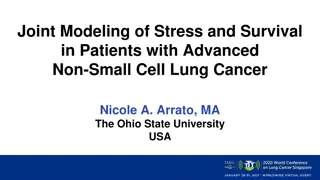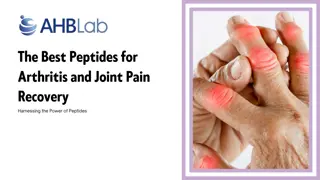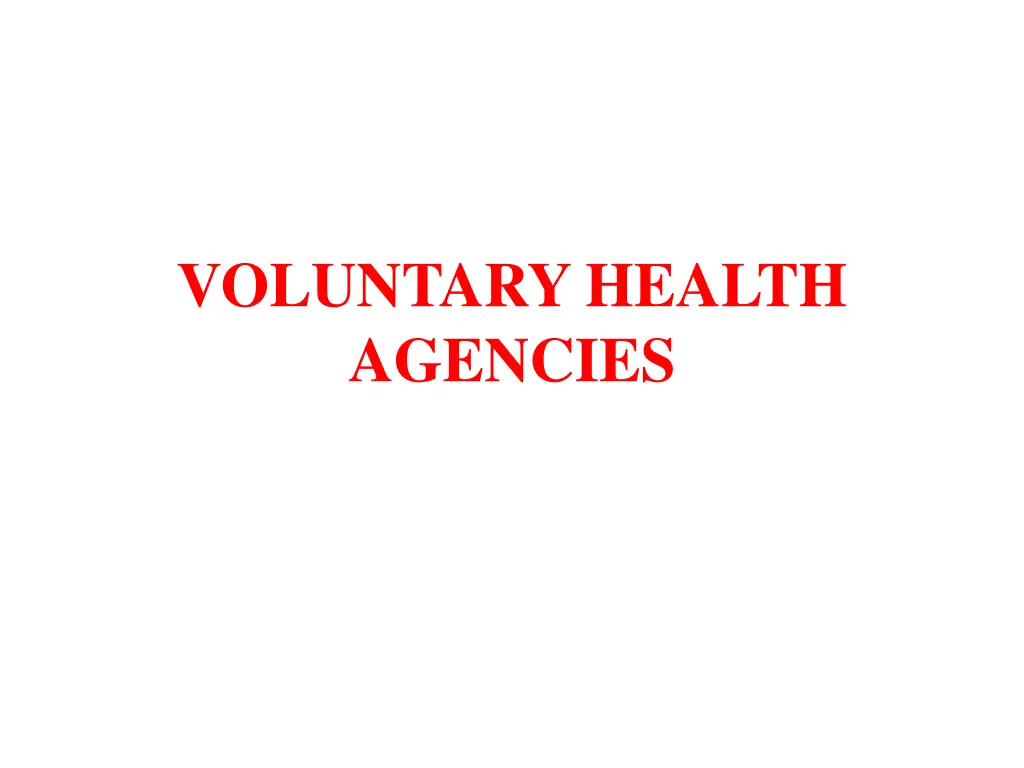
Overview of Voluntary Health Agencies and Their Advantages
Explore the history, functions, and advantages of voluntary health agencies, nonprofit organizations working towards public health improvement through various programs and services. Learn about the origins of voluntarism in healthcare, particularly in India, and the benefits of community participation in these organizations.
Download Presentation

Please find below an Image/Link to download the presentation.
The content on the website is provided AS IS for your information and personal use only. It may not be sold, licensed, or shared on other websites without obtaining consent from the author. If you encounter any issues during the download, it is possible that the publisher has removed the file from their server.
You are allowed to download the files provided on this website for personal or commercial use, subject to the condition that they are used lawfully. All files are the property of their respective owners.
The content on the website is provided AS IS for your information and personal use only. It may not be sold, licensed, or shared on other websites without obtaining consent from the author.
E N D
Presentation Transcript
VOLUNTARY HEALTH AGENCIES
2 INTRODUCTION An organization that is administered by an autonomous board which hold meeting, collects funds for its support chiefly from private sources & expends money, whether with or without paid workers, in conducting a programme directed primarily to furthering the public health by providing health services or health education, or by advancing research or legislation for health, or by a combination of these activities
Non-political, non-profit based, independent organization having an autonomous body consisting of a group of members, which holds meeting periodically, collects funds from private sources, philanthropists, government , etc.., spend money for one of following intentions- 1. Religious or missionary organization-promotion of a religion 2. Welfare organization-social relief and welfare 3. Professional body-Protection of interests of profession-IMA 4. Voluntary health agency-provision of health services
4 The United States ofAmerica - 20,000 voluntary agencies functioning Voluntary health agencies motor trucks Official agencies railway truck lines
5 HISTORY Health care in India has a long tradition of voluntarism. For centuries, traditional healers have taken careof the health needs of their own community. Then, the institutionalized voluntarism evolved during the colonial era.
6 Christian missionaries startedwork Verrier Elwin, keen to civilize primitivetribes Built school, health centers, hostels,churches. Gandhian Era- active in tribalareas Emphasis on khadi, village industries, landco- operatives, health and education.
7 ADVANTAGES: Betteraccepted Community participation is better in programs Programs are flexible and not rigid Not handicapped by bureaucratism and red tapism Work at fast pace and low operative costs Provide opportunity to individuals interested in social work
8 LIMITATIONS: Programs are related to non-critical health problems Services not always targeted to those who are in greatest need or area which needs them most Programs often do not run according to modern principles and techniques of management
9 FUNCTIONS : 1.Supplementing the work of government agencies 2.Pioneering- ways & means of doing new things 3.Education 4.Demonstration 5.Guarding the work of government agencies 6.Advancing health legislation
NON GOVERNMENTAL ORGANIZATIONS (NGOS) IN INDIA
10 ORGANIZATIONS FOR COMMUNICABLE DISEASES 1.Tuberculosis Association of India(TAI) 2.Hind Kusht Nivaran Sangh(HKNS)
11 TUBERCULOSIS ASSOCIATION OF INDIA(TAI) Established on Feb 23, 1939 Incorporating the King Emperor's Anti- Tuberculosis Fund and King George Thanks- giving (Anti-Tuberculosis) Fund. Headquarters New Delhi, branches in all states
12 ACTIVITIES:- Organizing a T.B. Seal campaign every year to raise funds Trainingof doctors & health workers in the control of TB Publishes periodicals related to TB Conducts annual conferences, encouraging research on TB
13 FOLLOWING INSTITUTIONS ARE UNDER THE MANAGEMENT: The New Delhi Tuberculosis Centre The Lady Linlithgow Sanatorium at Kasauli The King Edward v11 Sanatorium at Dharampur Tuberculosis Hospital at Mehrauli
14 HIND KUSHT NIVARAN SANGH Found in 19 Aug 1949 Headquarters - New Delhi, branches all over India Precursor Indian Council of the British Empire Leprosy Relief Association (B.E.L.R.A)
15 ACTIVITIES :- Financial assistance to leprosy homes & clinics Health education through publications & posters training to medical workers & physiotherapists Conducts research & field investigations Holds periodic leprosy conferences Quarterly journal Leprosy in India
16 FOR NON-COMMUNICABLE DISEASES ALL INDIA BLIND RELIEF SOCIETY Established 1946 Main function relief of blind Works in co-ordination with different institutions working for the blind
17 ACTIVITIES : -Eye camps for identification of preventable blindness Cataract surgery camps(recently with IOL implantation) Free spectacles for refractory correction
18 FOR RCH 1.Indian Council for Child Welfare 2.Central Social Welfare Board 3.The Kasturba Memorial Fund 4.All India Women s Conference 5.Child Relief & You (CRY)
19 INDIAN COUNCIL FOR CHILD WELFARE Established -1952, single largest agency, promoting development services for child. Network all over India Focus- Child welfare & development Promote enactment of legislation & reform Programmes:-
20 Advocating Children's Rights Creches for children of working and ailing mothers Training programmes for child care workers Sponsorship for School Education of under- privileged children Projects for Street and Working children Scrutiny of Adoption Cases Rehabilitation of Abandoned Children
21 Institutional and day care services for differently abled children Programmes for children in difficult circumstances Programmes with special focus on the girl child Education Centres and Support Services Honouring Children for Bravery Honouring ChildArtists National Integration Camps/ Adventure Camps
22 CENTRAL SOCIAL WELFARE BOARD Established august 1953 The founder Chairperson of the Board, Dr. Durgabai Deshmukh Autonomous body under Ministry of education
23 FUNCTIONS :- Surveying the needs & requirements of voluntary welfare organizations Promoting & setting up of social welfare Financial aid to deserving organizations Family & Child Welfare Services - initiated 1968
24 Short stay home programme-started in 1969 to provide temporary shelter to women and girls, Who are forced into prostitution Family tension or discord made to leave homes due to marital disputes Sexually assaulted Scheme of industrial co-operatives lower middle class women
25 THE KASTURBA MEMORIAL FUND Created 1945 Commemoration of Smt. Kasturba Gandhi Activities- improving the lot of women(rural) through gram-sevikas Various other welfare projects
26 ALL INDIA WOMEN S CONFERENCE Only women s welfare organization Established 1926, Margaret Elizabeth Dedicated for upliftment & betterment of women & children Running MCH clinics adult education centre(female literacy) milk centres family planning clinics
27 CHILD RELIEF & YOU (CRY) Founded 1981 Rippan Kapur Street children, bonded children, children of CSW, children of remand homes Helps in schooling as well as sports Raises funds through greeting cards
28 FOR RESCUE & RELIEF INDIAN RED CROSS SOCIETY Established - 1920, commendable in alleviation of human suffering Young Swiss businessman, Jean Henry Dunant During the first world war in 1914, India had no organization for relief services to the affected soldiers Over 400 branches throughout country
29 Creation of better society where vulnerable lead life of social & economic security & dignity ACTIVITIES :- 1.Relief Work 2.Milk & medical Supplies 3.Armed forces 4.Maternal & child welfare societies 5.Family planning 6.Blood bank & first aid- St John Ambulance Association
30 FOR FAMILY WELFARE PLANNING FAMILY PLANNING ASSOCIATION OF INDIA Founded in Bombay 1949 Devoted to promoting knowledge family planning as basic human right & population policies Voluntary commitment to advocate for SRH, Rights and choices.
31 HEAD QUARTERS-Mumbai 38 branches,4 project areas,30 integrated rural project FPAI- programme on information, education, motivation. MCH, training & research ACTIVITIES education of school college students & youth workers
32 Help couples to plan spacing & number of children FPAI-Organizes conferences, seminars, workshop Set up Family Life And Marriage Counselling Address reproductive & sexual concerns STD/AIDS prevention
33 Sex education, counselling, research, training/therapy (SECRT) centres Specialised services on family life, marriage & sex counselling . Prevention and counselling of STI/AIDS Sexual health programme for youth, parents, educators, disabled &mentally handicapped Training courses & workshop on human sexuality
34 Sexual Health- integrated into FPAI FPAI- co-operates with government in formulation of policies & programmes. In 1991,FPAI created network of NGOs for Development Environment & Population called INENGODEP, a fast expanding, seeks mutually reinforcing strategies to improve quality of life.
35 FPAI founder member of International Planned Parenthood Federation, London- 150 member Funding sources are government grants, donations, international funds.
36 FOR RURAL HEALTH BHARAT SEVAK SAMAJ Is a non official non political organization Set up in 1952 Helps people to achieve health by the own efforts & actions Main activity- improvement of sanitation in villages
37 FOR COMMUNITY DEVELOPMENT VOLUNTARY HEALTH ASSOCIATION OF INDIA Is non-profit, formed 1970 Federation of 24 state voluntary health association, linking 4000 health institution & grass root community health programs Objectives-make health a reality by promoting community health, social justice and human rights related to health care in India.
38 Works for women health & development Sex determination female foeticide & gender violence Adolescent health major concern Relief and rehabilitation in areas affected by disasters and calamities
39 FOR PROFESSIONAL ACTIVITIES Indian MedicalAssociation Indian Dental Association Trained Nurses Association of India
40 INDIAN MEDICAL ASSOCIATION The Association was started in 1928 on the occasion of the 5th all India Medical Conference at Calcutta with the objectives: Promotion and Advancement of Medical and allied sciences in all their different branches. The improvement of public Health and Medical Education in India. The maintenance of honour and dignity of medical profession.
41 HEADQUARTERS New Delhi 1650branches with a total membership of 2,15,000 throughout the country. Publishes a Scientific Journal called Journal of the Indian MedicalAssociation Your Health in english and Aap Ka Swasthya in hindi are published regularly and cater to health education needs of the lay public.
42 Relief camps during natural calamities health check up camps blood donation camps screening camps
43 INDIAN DENTAL ASSOCIATION Setting up quality standards in professional education in dental profession Dental check ups, awareness programmes are conducted
44 TRAINED NURSES ASSOCIATION OF INDIA Formed 1952 OBJECTIVES :- Nursing care of children Nursing care of elderly Blood donation camps First aid facility Vocational rehabilitation Relief work with Red Cross, IMA
45 INTERNATIONAL VOLUNTARYHEALTH ORGANISATION ROTARY INTERNATIONAL- is a service club, formed in 1905 Head quarters in Illinois & Paul P.Harris was the founder Brings together business & professional bodies for humanitarian service
46 Motto is SERVICE ABOVEALL Current global project is POLIO PLUS Other programme- Rotary Youth Exchange & scholarship, centres for international studies etc.
47 LIONS CLUB INTERNATIONAL Formed in 1917. Motto WE SERVE Head quarters in USA Major initiatives are Sight first programme Childhood blindness project
48 Lions eye health program River blindness/ trachoma Sight for kids Vision screening DISABILITYPROGRAMMS Diabetes prevention Habitat for humanity partnership



